Nyerere National Park was created in 2019 from part ofthe Selous Game Reserve which covered an area of 54600 km2. That's four times bigger than the Serengeti, twice the size of The Kruger National Park and Bigger than the country of Switzerland. Nyerere is 30893 km2. Look at this map of Nyerere/Selous to see how the area has been divided up.
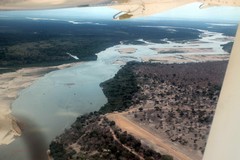
Rufiji river and Impala Camp airstrip
Selous was named after Englishman Sir Frederick Courteney Selous, a big game hunter and conservationist who died at Beho Beho fighting the Germans in WW1.
Since the forming of Nyerere National Park hunting is no longer allowed in this area. It still continues in what's left of Selous East of the Rufiji.
The Rufiji river drains the whole of the area from the Southern highlands and turns East in the North of the Reserve where it passes a series of lakes which offer exceptional wildlife viewing from boats.
Elevation is from 80m in the North to 1300m in the Mbarika mountains in the Southwest.
The area receives rainfall ranging from 750mm in the East to 1300mm in the West.
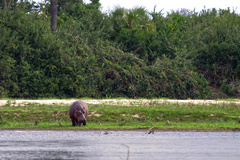
There are thousands of hippos on the Rufiji river.
They are best observed by taking a boat safari
Soils are generally thin and poor. They are commomly alluvial and underlain by the Karoo sandstone. Vegetation habitats include acacia-terminalia woodlands and savannah in the North with wetlands and a large area of miombo woodlands in the rest of the reserve. It is hilly especially towards the south. Game tends to congregate nearer to the river as the dry season progresses
There are 2149 recorded species of plants, and there may be many more in the interior.
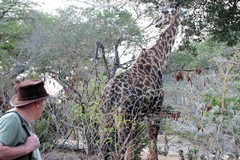
Resident giraffe in Impala camp
There is a huge amount of game in the Park; 15,000 elephants, (numbers have plummeted due to poaching since 2006 but are now stabilised and probably increasing in 2023), 145,000 buffalos, 40,000 hippos, 4000 lions, and it is a major stronghold for African hunting dogs with as many as 1500. 430 species of birds have been seen. There are so many giraffes that it is sometimes known locally as 'Giraffic Park'. There are also a few (100-400) black rhino in several scattered populations although these are always under threat because rhino horn is currently being sold for over £40000 per kilo on the black market. They are only rarely seen and are kept under guard as far as possible.
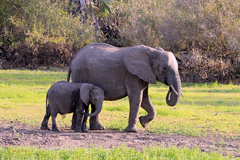
Between 2009 and 2014 elephants suffered
massively from poaching in Selous. Now it
seems to be largely stopped and the elephant
population is recovering
Threats are from poaching, both for ivory as a result of a huge increase in demand from the Far East since 2009. In the last few years the government has made major efforts to tackle ivory poaching and the situation is far better than it was.
Part of the reserve boundary in the South was redefined to allow for Uranium Mining, although other forested areas are meant to be added to the reserve to compensate for this. There is also a small amount of illegal logging although it remains low at present.
There is now a project underway at Steigler's gorge to create a huge dam. Roads have been cut to the area and up to three percent of the reserve will be flooded. The area to be flooded is being logged. Long term I have no idea what the effects of this will be on the reserve and also the people who live downstream of the dam who depend on the Rufiji for their livelyhood
Game viewing and photography, especially from small boats, is superb and gives a new way to approach wildlife very closely. Crocodiles and hippos are particularly good to see like this, as well as the many types of birds that depend on the river.
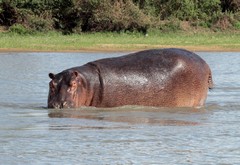
Hippopotamus in the shallows. Hippos favour
the shallow lakes in the area as well. The
hippopotamus, strangely, cannot swim. It runs
along the bottom and pushes itself up to breath
Great fishing with rod and line can also be had, especially for tigerfish and some very large catfish.
There are only a few tented camps located in the North of the reserve, and these tend to be small and very luxurious. Many of the guides are ex Park Rangers and have an enormous knowledge of the plants and animals of Selous.
Due to its vast size, isolation, thick bush, and low traffic, Selous is one of the places that really make you feel that you are as far out into the wilderness as you can get. Sometimes patience is needed to find certain animals but the abundant life around the rivers more than makes up for that. The secret of Selous is to spend as many nights there as possible and soak up the atmosphere of wild Africa.
Watch the Selous in September video.